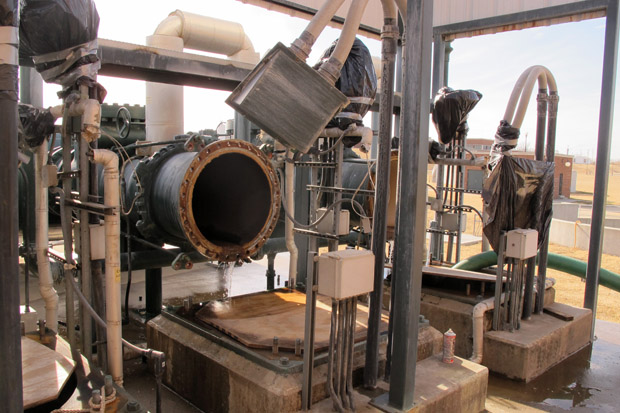
Waterworks at the Mohawk Water Treatment Plant in Tulsa, Okla.
Logan Layden / StateImpact Oklahoma


Waterworks at the Mohawk Water Treatment Plant in Tulsa, Okla.
Logan Layden / StateImpact Oklahoma
Tulsa’s water system is one of the largest in the state, and as StateImpact has reported, serves rural water districts and communities well beyond the city limits.
And it’s been lucky. The recent drought hasn’t been as severe for the Tulsa area, and it’s in the eastern half of the state, where most of the surface water is located.
While many cities and towns across the state face millions of dollars in repairs to crumbling pipelines and treatment plants, Tulsa’s water infrastructure has no major pressing needs.
Still, Tulsa has significant water problems. The culprit? A manpower shortage. As the Tulsa World’s Kevin Canfield reports:
The loss of experienced personnel and the inability to attract and retain new workers is compromising the city’s effort to maintain the pipes and valves the keep water flowing into homes and businesses, according to an internal memorandum issued earlier this year.
“There’s no question that Distribution Systems is at a crossroads of being a fully operational entity or just a stop-gap for situations,” Rick Caruthers, section manager of Distribution Systems, wrote in January.”
Caruthers sees low wages as the source of the shortage. Tulsa starts new workers at $10.42 per hour. That’s less than a number of cities in the region, including Lawton, Edmond, Broken Arrow, and Wichita, Kansas.

Logan Layden / StateImpact Oklahoma
Tulsa Water and Sewer Department Director Clayton Edwards received the Distribution Services memo earlier this year.
And working for Distribution Services isn’t exactly cushy. Water emergencies can happen at anytime during the day or night, whether there are two-inches of ice on the roads or a major thunderstorm moving through.
The World reports to keep up with maintenance, mandatory overtime has been implemented four times in the last two years, and the city has turned to temporary workers:
In the past two years, Distribution Systems has retained only 35 percent of its new hires, according to Caruthers.
“Under normal staffing with quality personnel, a main line leak would be scheduled for repair two weeks after receiving the service order,” Caruthers wrote. “Now the repair may be scheduled in four to eight weeks.”
And as Tulsa’s service area continues to grow, the pressure on Distribution Services will only increase.
Tulsa Mayor Dewey Bartlett earlier this week put in place a hiring freeze city employees, but it does not apply to the Water and Sewer Department, and other departments that get their funding from customers.